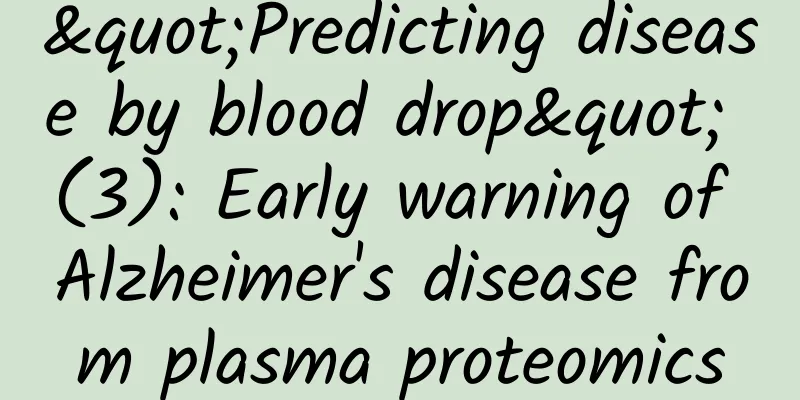"Predicting disease by blood drop" (3): Early warning of Alzheimer's disease from plasma proteomics

|
In the previous "Predicting Diseases by Dropping Blood" special topic, we introduced how plasma proteomics can effectively predict the risk of diabetic nephropathy and atrial fibrillation. This time, we focus on whether plasma proteomics can help us detect the risk of Alzheimer's disease in advance. Let's learn about it together! Alzheimer's disease (AD) is a neurodegenerative disease involving multiple biological processes. It not only has a high incidence rate and a long course of disease, but also has very high disability and mortality rates. However, there is currently no drug that can effectively cure or significantly slow the progression of the disease. Therefore, identifying high-risk groups in advance and conducting early prevention may be the key to reducing the personal and social burden caused by Alzheimer's disease. (The picture comes from the Internet, the copyright belongs to the original author) In the past few years, the biomarker-based amyloid/Tau/neurodegeneration (A/T/N) framework has been widely used in Alzheimer's disease research, but its limitations are also obvious: it is not only highly invasive and costly, but also fails to fully cover the entire pathological process of Alzheimer's disease. In addition, some existing Alzheimer's disease prediction models usually rely on information that is difficult to obtain in the clinic, such as imaging data, cognitive tests, and cerebrospinal fluid biomarkers, which also limits their clinical application. With the development of blood testing technology in recent years, we can obtain large-scale plasma protein data through blood sample analysis. Plasma proteomics not only participates in the regulation of various biological processes, but also combines factors such as genes, environment, age, behavior, comorbidities and treatment. So, is it possible to predict the risk of developing Alzheimer's disease in the future by simply collecting blood and testing the levels of a small amount (several to dozens) of proteins in the body? This question has not yet been determined. In response to the above problems, the National Clinical Research Center for Kidney Diseases of Nanfang Hospital of Southern Medical University carried out relevant work, and the research results were published in the journal Aging Cell. Based on the data of about 3,000 plasma proteins, the study found that the Alzheimer's disease risk model constructed by 31 proteins can effectively predict the risk of Alzheimer's disease. The study included 35,547 participants without dementia at baseline. Participants were divided into a development cohort and a validation cohort based on the distribution of research centers, and the development cohort was further randomly divided into a training set and a validation set. **In the training set, 31 proteins related to new-onset Alzheimer's disease were screened, and a plasma protein prediction model was constructed based on this. ****The protein model showed good Alzheimer's disease risk prediction ability in both the development cohort validation set (C index = 0.867) and the validation cohort (C index = 0.912). **In addition, compared with the existing genetic risk models (APOE genotype) and clinical risk prediction models (CogDrisk-AD), this protein model significantly outperformed or significantly improved their predictive performance. Even if only the top ten proteins in the model are considered, the risk of Alzheimer's disease can still be effectively predicted. (Figure 1) Figure 1. Cumulative C-index of the top 10 proteins with the largest absolute coefficients in the Alzheimer's disease protein model Through further enrichment analysis and network analysis of these 31 proteins, it was found that EGFR, GFAP and CHGA are key proteins in the interaction network of candidate proteins for Alzheimer's disease****. (Figure 2) Figure 2. Protein enrichment and protein interaction network analysis The collection of blood samples is very convenient in clinical settings, and plasma protein testing is highly objective, quantifiable, and easy to operate. Compared with clinical risk factor collection methods that rely on participant reports, medical records, or multiple tests, plasma protein testing has obvious advantages in large-scale screening. Our results show that Alzheimer's disease can be effectively predicted by simple plasma protein testing without the need for complex face-to-face clinical assessments. This provides a simpler and more efficient method for predicting Alzheimer's disease, especially for large population screening and early risk identification. In this way, high-risk individuals can be quickly identified, and precise management and prevention can be carried out, thereby improving the effectiveness of early intervention for Alzheimer's disease. Reference: Yang S, Ye Z, He P, et al. Plasma proteomics for risk prediction of Alzheimer's disease in the general population. Aging Cell*.* Published online September 9, 2024. doi:10.1111/acel.14330 Editor | Yang Sisi and Zhang Yiwei Audit | Qin Xianhui |
<<: Diabetic patients need to be alert to the "sweet killer" that attacks hearing health
>>: "Diving" cooling is coming! Experts remind: Beware of this kind of disease
Recommend
Correctly understand anesthesia, you need to know these three points
1 | What is anesthesia Simply put, anesthesia is ...
What delicacies can be made with dried mango? Can dried mango be stored in the refrigerator?
The taste of dried mango is sweet and sour, but n...
Eight things women should avoid: make men think you are pretending
Women in love pay great attention to their faces ...
What essential oils to use to reduce belly fat
In recent years, essential oil care is a common m...
What is the treatment for menstrual abdominal pain?
Women have menstruation every month. Some women w...
How long is normal to bleed after a miscarriage?
In life, many people are very concerned about the...
Do electric blankets need to be cleaned? How to clean dirty electric blankets?
Since October, the weather has been getting colde...
Disgusting stretch marks pictures
For pregnant women, stretch marks are very easy t...
How long does it take for physiological ovarian cysts to disappear?
If it is a physiological ovarian cyst, women do n...
Where is Keemun black tea produced? How to choose Keemun black tea
Keemun black tea is a famous tea in my country. T...
What does a girl smell like down there?
I believe every woman is very concerned about the...
What will the pregnant woman do if the fetus has no heartbeat?
Fetal heartbeat is the basis for judging whether ...
Can I get pregnant when my period is coming?
It is also easy to get pregnant when menstruation...
Can I exercise to lose weight during menstruation?
Exercise for weight loss is a very popular way of...
What are the symptoms of urinary tuberculosis in women?
What people often call urinary tuberculosis actua...









